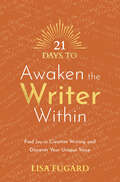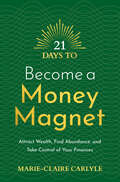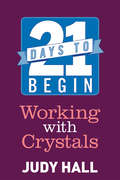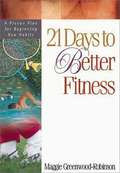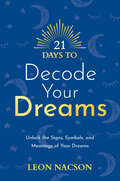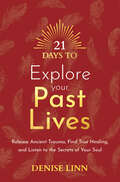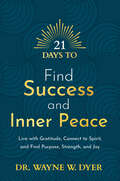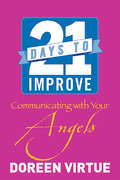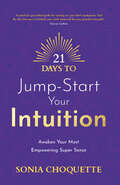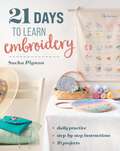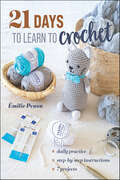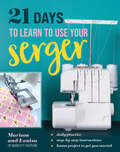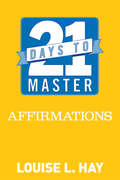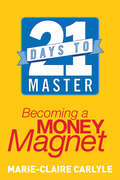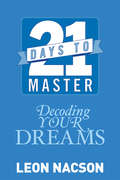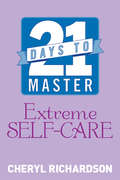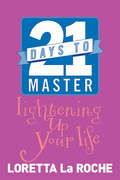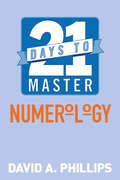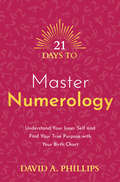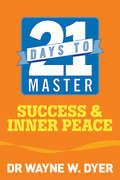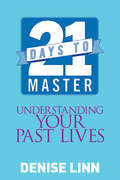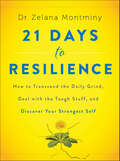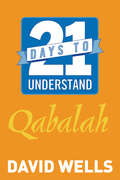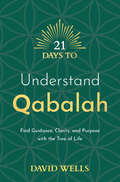- Table View
- List View
21 Days to Awaken the Writer Within: Find Joy in Creative Writing and Discover Your Unique Voice (21 Days #6)
by Lisa FugardStudies have shown it takes only 21 days for a new habit to take root. If there's a spiritual interest you've always wanted to take advantage of, the answer is only 21 days away with the 21 Days to Mastery Series.How do you sustain your ideas and overcome self-doubt in your talents? How do you transmit your ideas so that the world will take notice? What techniques can you use to create discipline and make your writing sessions a joy? We live in exciting times in publishing: anyone with an idea and a computer can reach a worldwide audience, but how do you separate yourself from the thousands competing to be heard? 21 Days to Master Awakening the Writer Within is a warm, comforting guide to stepping into your new life as an empowered author. You'll learn how to generate more ideas, build confidence in your writing and take your manuscript to completion.
21 Days to Become a Money Magnet: Attract Wealth, Find Abundance, and Take Control of Your Finances
by Marie-Claire CarlyleDiscover practical tools and tips to attract prosperity, success, and happiness into your life and find your breakthrough moment in money management with the Law of Attraction.Do you wish you could transform your finances and break negative patterns? We all want abundance and security in life, but it can sometimes feel impossible. Discover the first step to financial freedom with this step-by-step guide from transformational coach Marie-Claire Carlyle. Over 21 days, you will discover:How to start attracting more money into your life immediately with principles from the Law of Attraction Exercises to help you change your negative money beliefs into positive statementsHow to create your own &‘I Attract Money&’ list and affirmations for becoming a Money MagnetHow to break the pattern of negative thinking to make room for wealthThis is your key to finding abundance. Use the practical advice, guidance, and inspirational tips to start attracting money today!"The money is already there. The only thing preventing you from being rich is YOU."Studies have shown it takes only 21 days for a new habit to take root. If there's a skill you've always wanted to take advantage of, the answer is only 21 days away with Hay House's 21 Days Series.
21 Days to Begin Working with Crystals
by Judy HallStudies have shown it takes only 21 days for a new habit to take root. If there's a skill you've always wanted to take advantage of, the answer is only 21 days away with Hay House's 21 Days Series.Judy Hall is recognised worldwide as an expert on crystals. Her bestselling book The Crystal Bible has become the definitive book on the subject. Here, she provides a powerful distillation of her wisdom into a short, practical programme that anyone can use to discover the remarkable powers of crystals.You'll look at specific crystals, some old some new, basic and advanced, earthy and of high vibration, so that no matter whether you're a complete beginner or an experienced crystal worker, you'll find something here to inspire and excite you. This book also looks at a huge variety of uses for crystals including chakra clearing, avoiding pollutants in your home and in the wider environment and for meditation. You'll also see why crystals are essential for energy-boosting, opening higher consciousness and for creating new patterns.Each day, you'll discover a different aspect of crystals, so you build skills that you can use across a variety of applications. Every day includes a practical activity to expand your sensitivity to crystal energy and help you explore its potential. In 21 days you will have tasted a wide spectrum of crystal possibilities.
21 Days to Better Fitness
by Maggie Greenwood-RobinsonHabits can be formed in 3 weeks, and this book teaches simple ways to live healthier in that time, in a religious context.
21 Days to Decode Your Dreams: Unlock the Signs, Symbols, and Meanings of Your Dreams (21 Days #4)
by Leon NacsonDiscover the deeper meaning of your dreams and understand the messages behind various signs and symbols in just 21 days.We've all experienced dreams that have given us pause for thought or wondered what deeper insight these night-time visitations have. Dreams can unlock the deepest parts of our minds, reveal solutions that the waking mind could not comprehend and provide important guidelines for our future. However, all of these valuable insights are useless to us without a simple, easy to refer to guide to the symbols and messages submerged into our dreams. 21 Days to Decode Your Dreams is the package all dreamers need.Your sleeping life holds the solutions to your waking life, and this book offers a comprehensive day-by-day guide to the most familiar themes, symbols and messages that our dreams transmit. In 21 days, you'll learn how to keep a dream journal, understand recurring dreams, break troubling patterns that your dreams warn you about and create an incredible dream life to enrich your conscious time.Studies have shown it takes only 21 days for a new habit to take root. If there's a skill you've always wanted to take advantage of, the answer is only a few weeks away with Hay House&’s 21 Days series.
21 Days to Explore Your Past Lives: Release Ancient Trauma, Find True Healing, and Listen to the Secrets of Your Soul (21 Days #5)
by Denise LinnA short, insightful guide to connecting with past lives to create a positive, healthy future.Your past lives hold the secret to healing yourself in the present. Find out how you can access this power in just 21 days. Your soul has experienced many lifetimes before manifesting in your body. Trauma and joy from past lives can reveal our unique emotional make up and explain physical ailments that trouble us today. People around the world have attested to the incredible awakening, healing, and insight that can be found in a deep connection to our past selves. Travelling through the ages has never been easier with highly respected teacher Denise Linn's guide to uncovering the truth of our lives before our births. The book includes easy-to-use techniques to help you examine clues in your current incarnation and recall events from your previous lives, and guidance on healing past-life blockages with regession. Removing limitations in relationships, realizing your future destiny, and uncovering the symptoms of past-life trauma and how to relieve it are all within your hands, wherever you are. You'll soon realise the potential you're capable of by calling on your previous incarnations and creating a connection with your spirit guide. If you've ever wanted to call on your deep personal history for growth and renewal, it only takes 21 days with this fantastic guide, designed to fit into any moment. Studies have shown it takes only 21 days for a new habit to take root. If there's a skill you've always wanted to take advantage of, the answer is only a few weeks away with Hay House&’s 21 Days series.
21 Days to Find Success and Inner Peace: Live with Gratitude, Connect to Spirit, and Find Purpose, Strength, and Joy (21 Days)
by Dr. Wayne W. DyerA guide to the secrets of leaving negativity behind and finding purpose in just 21 days.Discover your true life purpose, open your mind and your heart to opportunity and potential, and lead a happy, successful life. Dr. Wayne W. Dyer was considered to be one of the world's top spiritual teachers, known worldwide for his warm, insightful wisdom. This empowering guide will show you that in just 21 days you can let go of negative mindsets and move past long-term problems, become open to the joy that is present all around you, and find inspiration to lead the life of your dreams. The easy-to-follow principles in this short book give you all you need to find a goal in life that is spiritually fulfilling and overflowing with happiness. Living life with an open heart and a clear purpose is only 21 days away with these incredible life-lessons. Studies have shown it takes only 21 days for a new habit to take root. If there's a spiritual interest you've always wanted to take advantage of, the answer is here with the 21 Days series.
21 Days to Improve Communicating with Your Angels
by Doreen VirtueStudies have shown it takes only 21 days for a new habit to take root. If there's a spiritual skill you've always wanted to take advantage of, the answer is only 21 days away with the 21 Days to Mastery Series.Doreen Virtue is the creator of Angel Therapy®, a system that allows you to connect with the heavenly power of angels. Angels can be called on to help with all of your problems: health, love, friendship, pets or even machinery! In just 21 days, you'll discover the method to contact these incredible celestial powers. Following some of Doreen Virtue's best-loved texts about getting in touch with archangels, ascended masters and all other powerful spiritual beings, this quick and easy to follow course is perfect for daily use. Whenever you're faced with a problem, you can call on the angels. This guide puts their power into your hands, wherever you are.
21 Days to Jump-Start Your Intuition: Awaken Your Most Empowering Super Sense
by Sonia ChoquetteAwaken your intuitive voice, honor your spirit, and discover how to make your heart&’s desire a reality with the expert guidance of world-renowned spiritual teacher Sonia Choquette.Your intuition is the voice of your authentic Self. Developing your intuition allows you to recognize that you are a spiritual being, connect with the sacred gift that is your sixth sense, and trust the inner light of your spirit to help you maneuver your way to a prosperous life.In this easy-to-follow guide to developing your intuition, Sonia will show you how to:tap into your intuition to lead you to a life filled with purpose rid yourself of self-doubt, confusion, and anxiety so you can truly enjoy all that life has to offerre-energize your spirit and manifest abundance21 Days to Jump-Start Your Intuition is packed with intuitive guidance, expert teachings, and practical exercises that will help you to trust your vibes so you can live fully, freely, and joyously.Studies have shown it takes just 21 days to establish a new habit. If there&’s a skill you&’ve always wanted to take advantage of, the answer is only a few weeks away with Hay House&’s 21 Days series.
21 Days to Learn Embroidery: Daily Practice, Step-by-Step Instructions, 16 Projects
by Sacha PignonMaster the art of embroidery in just 21 days! Explore embroidery like never before through this book’s immersive journey! Within each page learn how to use different types of embroidery from classic stitches to innovative techniques like combining beads, sequins, paint, and more! Customize projects like a crafty stitch book, a stunning hanging French herbarium, and more! Over 21 days, transform everyday objects into personalized masterpieces with expert embroidery instruction and tips, beautifying your clothes and home and delighting loved ones with heartfelt gifts. Go from beginner to confident stitcher with step-by-step embroidery instructions, where each day brings a fresh new lesson Learn how to up your embroidery game with materials like silk and metallic threads, wool, ribbon, and embellishments like beads, rhinestones, sequins, and paint Master the essentials of embroidery, cross stitch, and sashiko while crafting fun projects at every turn of the needle
21 Days to Learn to Crochet: Daily Practice, Step-by-Step Instructions, 7 Projects
by Émilie PenouMaster the art of crochet in just 21 days!In 21 days, you&’ll learn everything there is to know about crochet! By alternating between learning and creating, this hands-on method helps you quickly master the essential techniques and stitches. Start your crochet journey with delightful projects like granny squares, tawashi, baskets, shawls, and amigurumi. With detailed step-by-step tutorials and illustrated photos, you&’ll make swift progress and gain the confidence to tackle any crochet project you dream up!Go from beginner to confident crocheter with step-by-step crochet instructions, where each day brings a fresh new lessonBuild muscle memory by practicing daily how to do basic stitches, color switches, and how to increase and decrease stitches with easeEnjoy a structured and fun learning experience following a proven formula: two days of learning, one day of goal-oriented practice, and one day for finishing touches
21 Days to Learn to Use Your Serger
by Mariam and Louisa of Modesty CoutureConquer your serger in just 21 days! In 21 days, you will learn how to use your serger confidently, learning threading, tension adjustment, various stitches, and more! Get to know your serger and discover the different needles, fabrics, threads, feet, basic stitches, and beyond. Each day brings a new assignment, building your skills step-by-step. By the end of the 21 days, you’ll be an expert at using your serger and ready to tackle your own projects! Go from beginner to confident serger with step-by-step guidance, where each day brings a fresh new lesson. Unlock the power of sergers with easily acquired knowledge and skills, transforming this intimidating machine into a valuable addition to your sewing arsenal. Enjoy bonus sections with essential tips and advice: common questions to ask when choosing your serger, 10 things to avoid, and the five most important tips.
21 Days to Master Affirmations
by Louise HayStudies have shown it takes only 21 days for a new habit to take root. If there's a spiritual skill you've always wanted to take advantage of, the answer is just 21 days away with the 21 Days to Mastery series.Louise L. Hay's teaching on affirmations have sold over 39 million copies worldwide and provided a healing technique that have comforted and healed countless people over the last 30 years. 21 Days to Master Affirmations makes this infinitely powerful skill as easy and as quick to learn as its ever been. You'll discover the power of simple, soothing words can be applied to any problem. Whether emotional or physical, Louise's teachings are available for you to call on at any time. You'll also learn how to create your own personalised affirmation that target persistent, perhaps lifelong personal issues and ailments. This e-book is the ideal introduction to the defining spiritual technique of the last 30 years, now presented in a format that fits into 21st Century living. Start healing your life in just 21 days!
21 Days to Master Becoming a Money Magnet
by Marie-Claire CarlyleStudies have shown it takes only 21 days for a new habit to take root. If there's a spiritual interest you've always wanted to take advantage of, the answer is only 21 days away with the 21 Days to Mastery Series.We all want abundance in all things, but getting what you want can sometimes seem impossible. 21 Days to Master Becoming a Money Magnet is your guide to harnessing the Law of Attraction and Feng Shui to bring prosperity and happiness into your life. Being rich starts with a state of mind and Marie-Claire's practical advice is as easy to follow as it is frank, funny and down-to-earth. You'll learn how to value yourself, break negative patterns that block your abundance and learn how to make your passion the heart of your prosperity. Take responsibility for the amount of money in your life and resolve to become a Money Magnet now!
21 Days to Master Decoding Your Dreams
by Leon NacsonStudies have shown it takes only 21 days for a new habit to take root. If there's a spiritual skill you've always wanted to take advantage of, the answer is only 21 days away with the 21 Days to Mastery series.We've all experienced dreams that have given us pause for thought or wondered what deeper insight these nighttime visitations have. Dreams can unlock the deepest parts of our minds, reveal solutions that the waking mind could not comprehend and provide important guidelines for our future. However, all of these valuable insights are useless to us without a simple, easy to refer to guide to the symbols and messages submerged into our dreams. 21 Days to Master Decoding Your Dreams is the package all dreamers need.Your sleeping life holds the solutions to your waking life, and this new e-book offers a comprehensive day by day guide to the most familiar themes, symbols and messages that our dreams transmit. In 21 days, you'll learn how to keep a dream journal, understanding recurring dreams, break troubling patterns that your dreams warn you about and create an incredible dream life to enrich your conscious time. This e-book will be available to you in searchable format whenever you need it. You'll soon see that though it only takes 21 days to master, your dreams are a treasure for the rest of your life.
21 Days to Master Extreme Self-Care
by Cheryl RichardsonStudies have shown it takes only 21 days for a new habit to take root. If there's a spiritual interest you've always wanted to take advantage of, the answer is only 21 days away with the 21 Days to Mastery Series.In the rush of everyday life we can often lose sight of our own well-being and inner comfort, to the point where we lose sight of how to bring deep pleasure into every day. In this short, easy-to-read guide, world-renowned life coach Cheryl Richardson shows you how to nurture life's most important relationship: with yourself! As each chapter challenges you to alter one behaviour or circumstance that holds you back, you'll learn how to understand the true impact of your surroundings, accept disappointments in all areas when they arise, find your natural rhythm and ride life's waves, and discover your passions and strengths to get the best out of your life.With sound advice, effective exercises and resources to take each step further, this practical handbook for the heart and mind will show you that by changing your mindset, you can radically change your life in just 21 days.
21 Days to Master Lightening Up Your Life
by Loretta LarocheStudies have shown it takes only 21 days for a new habit to take root. If there's a spiritual interest you've always wanted to take advantage of, the answer is just 21 days away with the 21 Days to Mastery Series.From time to time, we all need reminding how to take life less seriously and simply enjoy ourselves. This short, easy-to-read guide will put you back in touch with your sense of humour and the joy of life. In quick, pick-me-up chapters, stress-management consultant Loretta LaRoche takes you on a hysterical journey from stressed to blessed – reminding you what it's like to be alive, connected with others, and savouring the present moment. Using amusing anecdotes from her own life, as well as the latest research in the fields of psychology and mind-body health, Loretta unveils simple techniques for living a life filled with laughter, compassion and delight. With this innovative title, you'll find an insightful word is always close to hand whenever you need a reminder on how to enjoy pleasure wherever you find it.
21 Days to Master Numerology
by David A. PhillipsStudies have shown it takes only 21 days for a new habit to take root. If there's a spiritual interest you've always wanted to take advantage of, the answer is just 21 days away with the 21 Days to Mastery Series.We may not notice, but numbers are all around us, and far from being random, they often have deep significance that can show us the key to our present and act as a guide to our future. Now, for the first time, there is a practical, easy-to-use guide to the power of numbers in our lives. Written by numerological expert David A. Phillips, 21 Days to Master Numerology lets you understand the underlying meaning of the numbers in your life and enables you to understand the connection between your numerological patterns and your degree of abundance, health and general wellbeing. Overall, delving into the world of numbers will provide you with a simple and accurate way to decipher your experiences in the same manner that a road map helps you to navigate a route that you haven't previously travelled. That road map is now available to you wherever you are and whenever you're wondering about the deeper significance of the numbers that surround us.
21 Days to Master Numerology: Understand Your Inner Self and Find Your True Purpose with Your Birth Chart (21 Days)
by David A. PhillipsIt takes just 21 days to establish a new habit. Discover how to use your birth chart to find your true inner self and create a life full of abundance, purpose and joy.Numerology is a practice that provides direct knowledge of the inner self through numerical information and your birth chart. It can help you to relate better to other people, become more emotionally and financially secure, maintain good health and live a thoroughly loving life. Above all, it can offer you a determined, successful and joyous course through life. In this in-depth, accessible guide, you&’ll discover:· what the numbers on your birth chart mean and how they can help influence your life for the better· how to find your ultimate purpose with your Ruling Number· how to set up and interpret a Number Pyramid in order to create a well-balanced life· the numerological power and meaning of names and how to compile your Name ChartThis is the perfect introduction to a useful, insightful practice, now presented in a format that fits your life.If there's a skill you've always wanted to learn, the answer is only a few weeks away with Hay House's 21 Days series.
21 Days to Master Success and Inner Peace
by Wayne W. DyerStudies have shown it takes only 21 days for a new habit to take root. If there's a spiritual interest you've always wanted to take advantage of, the answer is just 21 days away with the 21 Days to Mastery Series.Dr Wayne W. Dyer is considered to be one of today's top spiritual teachers, known worldwide for his warm, insightful wisdom on transforming your life. This innovative new title will show you that in just 21 days you can let go of negative mindsets and move past long term problems, become open to the joy that is present all around you and find inspiration to lead the life of your dreams. The easy-to-follow principles in this short book give you all you need to find a goal in life that is spiritually fulfilling and overflowing with happiness. Living life with an open heart and a clear purpose is only 21 days away, using the 'father of self-motivation''s incredible life-lessons.
21 Days to Master Understanding Your Past Lives
by Denise LinnStudies have shown it takes only 21 days for a new habit to take root. If there's a spiritual interest you've always wanted to take advantage of, the answer is only 21 days away with the 21 Days to Mastery Series.Your soul has experienced many lifetimes before manifesting in your body. Trauma and joy from past lives can reveal our unique emotional make up and explain physical ailments that trouble us today. People around the world have attested to the incredible awakening, healing and insight that can be found in a deep connection to our past selves. Travelling through the ages has never been easier with Denise Linn's guide to uncovering the truth of our lives before our births. Removing limitations in relationships, realising your future destiny and uncovering the symptoms of past-life trauma and how to relieve it are all within your hands, wherever you are. You'll soon realise the potential you're capable of by calling on your previous incarnations and creating a connection with your spirit guide. If you've ever wanted to call on your deep personal history for growth and renewal, it only takes 21 days with this fantastic guide, designed to fit into any moment.
21 Days to Resilience: How to Transcend the Daily Grind, Deal with the Tough Stuff, and Discover Your Strongest Self
by Zelana Montminy“21 Days to Resilience gives us a powerful map we can apply to grab ahold of radical wellbeing and happiness in our daily lives, for real.” —Tara Stiles, bestselling author of Clean Mind, Clean BodyHappiness is not about wishful thinking, good luck, or avoiding negative thoughts. In fact, the only path to true happiness requires seeing challenges as opportunities and discovering emotional strength during times of struggle. In other words, it’s about resilience—a quality most of us want to possess. The big issue is that no one knows how to access it in their day-to-day life. How we actually attain the skills to become resilient has been left out of the conversation. Until now.In 21 Days to Resilience, Dr. Zelana Montminy, a leading expert in positive psychology, offers a practical, science-backed toolkit to develop your capacity to handle whatever life throws your way—and thrive. Each day of her powerful program, Dr. Montminy introduces a key trait necessary to improve resiliency and enhance wellbeing, such as gratitude, focus, playfulness, self-respect, and flexibility, then provides three simple tasks to accomplish that day—one in the morning, one during the day, and one in the evening. In addition, the book offers a “Take Stock” section that will help you gauge your current level of skill and each chapter ends with a “Lifelong” exercise that offers ways to build the skill as needed to keep your resiliency muscles strong.Combining proven science, unique exercises, and insights from real-life experience, 21 Days to Resilience lays the foundation for happiness and shows you how to build your strength to carry you through the rest of your life.
21 Days to Understand Qabalah
by David WellsStudies have shown it takes only 21 days for a new habit to take root. If there's a spiritual interest you've always wanted to take advantage of, the answer is only 21 days away with the 21 Days to Mastery Series.The Qabalah is an ancient system that underlies some of the world's best known divination tools and spiritual paths, yet no simple guide to unlock it's incredible power yet exists. Breaking through the complexity, Qabalah expert and well-known psychic David Wells is here to show you how the messages you can gain from the Qabalah are powerful and life-changing. With this easy-to-follow guide, you'll quickly understand the deep symbolism of each part of the Tree of Life, untap your deepest intuition and develop an amazing new route through your daily life and for your future.
21 Days to Understand Qabalah: Find Guidance, Clarity, and Purpose with the Tree of Life (21 Days)
by David WellsIt takes just 21 days to establish a new habit. Discover spiritual illumination and how to fulfil your life's purpose with Qabalah. Qabalah is a Western non-religious mystic tradition containing magical knowledge and practices to help you fulfil your destiny. This introductory book breaks down the ideas of the Tree of Life into an easy-to-follow path, including daily workshops that guide you gently through understanding Qabalah. Over 21 days you will learn: · the role of the Tree of Life and the links between Qabalah and tarot · the meaning of each sphere, or Sephira, on the Tree, with an exercise and meditation for each one · how to increase the energy for your meditations and create a personal symbol, or sigil, to represent your highest values · how to use Qabalistic prayer and work with the four great Archangels for daily support and protection If there's a skill you've always wanted to learn, the answer is only a few weeks away with Hay House's 21 Days Series.
21 Days to Unlock the Power of Affirmations: Manifest Confidence, Abundance, and Joy (21 Days)
by Louise HayAn easy-to-follow guide to affirmations from inspirational teacher Louise Hay.Discover how to use affirmations to soothe your soul and heal your body in just 21 days. Louise Hay's teachings on affirmations are multi-million copy bestsellers worldwide and have provided techniques that have comforted and healed countless people. 21 Days to Unlock the Power of Affirmations makes this infinitely powerful skill easy and quick to learn. You'll discover the power of simple, soothing words and how these can be applied to any problem. Whether emotional or physical, Louise's teachings are available for you to call on at any time. You'll also learn how to create your own personalised affirmation to target persistent, perhaps lifelong personal issues and ailments. This is the ideal introduction to an essential technique, now presented in a format that fits your life. Start healing your life in just 21 days! Studies have shown it takes only 21 days for a new habit to take root. If there's a spiritual interest you've always wanted to take advantage of, the answer is here with the 21 Days series.
